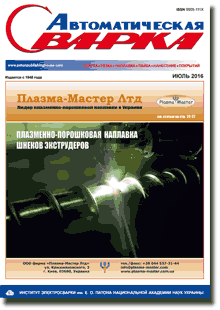| 2016 №07 (08) |
DOI of Article 10.15407/as2016.07.09 |
2016 №07 (01) |

Avtomaticheskaya Svarka (Automatic Welding), #7, 2016, pp. 52-55
Oxygen influence on the process of nitrogen-induced pore formation in consumable electrode arc welding
V.A. Pisarev And S.N. Zhiznyakov
Belarussian National Technical University, 65 Nezavisimost Ave., 220013, Minsk, Belarus Republic. E-mail: niil_svarka@bntu.by
Abstract
Nitrogen-induced porosity is one of the most common defects in welded joints produced by consumable electrode arc welding, particularly, in open sites. It is believed that in order to produce sound welds in low-carbon and low-alloyed steels, their nitrogen content should not exceed 0.01–0.03 %. At the same time, cases of producing tight welds at up to 0.18 % nitrogen content are found in practice. This is indicative of the fact that alongside nitrogen concentration and temperature, other factors also have a determinant influence on the process of nitrogen-induced pore formation. One of such factors, as shown by the conducted analytical and experimental investigations, is oxygen present in weld pool metal. It is capable of slowing down penetration of nitrogen atoms from the melt into the gas cavity of developing nucleus or bubble (effect of oxygen adsorption inhibition). The newly established regularity was used in development of the technology of CO2 welding of steel structures in open sites under the impact of wind with the speed of up to 8–10 m/s. 11 Ref., 1 Table, 1 Figure.
Keywords: arc welding, pores, nitrogen, adsorption inhibition, tight weld, technology
Received: 04.04.16
Published: 02.08.16
References
- Novozhilov, N.M. (1979) Principles of metallurgy of gas-shielded arc welding. Moscow: Mashinostroenie.
- Alov, A.A. (1947) Electrodes for arc welding and surfacing. Moscow: Mashgiz.
- Alov, A.A. (1969) Principles of theory of welding and brazing processes. Moscow: Mashinostroenie.
- Pokhodnya, I.K. (2004) Metallurgy of arc welding. Interaction of metals with gases. Moscow: Mashinostroenie.
- Ershov, G.S., Majboroda, V.P. (1990) Diffusion in metallurgical melts. Kiev: Naukova Dumka.
- Erokhin, A.A. (1973) Principles of fusion welding. Moscow: Mashinostroenie.
- Konishchev, B.P., Kurlamov, S.A., Potapov, N.N. et al. (1989) Welding consumables for arc welding. Shielding gases and welding fluxes, Vol. 1. Moscow: Mashinostroenie.
- (1993) Welding consumables for arc welding. Welding wire and electrodes, Vol. 2. Moscow: Mashinostroenie.
- Kudrin, V.A. (2003) Theory and technology of steel making: Manual. Moscow: Mir.
- Rimsky, S.T. (2008) Methods for increase of weld metal resistance to crack formation in shielded-gas arc welding. Svarshchik v Belorussii, 4, 15–18.
- Zhiznyakov, S.N., Timalev, L.N. (1977) Influence of oxygen on welding process in CO2 + O2 Svarochn. Proizvodstvo, 2, 25–27.
